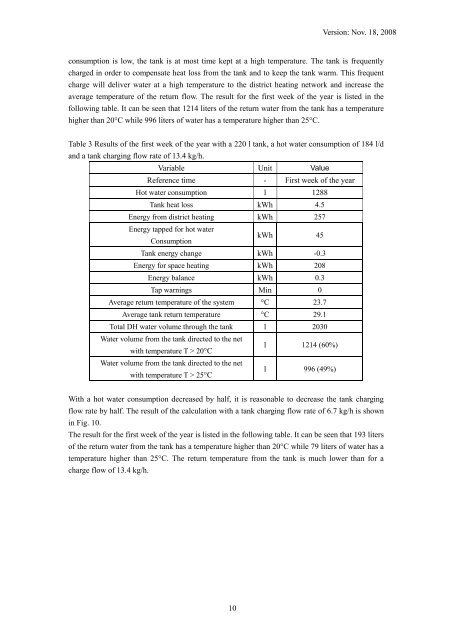Udvikling og demonstration af lavenergifjernvarme til lavenergibyggeri
Udvikling og demonstration af lavenergifjernvarme til lavenergibyggeri
Udvikling og demonstration af lavenergifjernvarme til lavenergibyggeri
You also want an ePaper? Increase the reach of your titles
YUMPU automatically turns print PDFs into web optimized ePapers that Google loves.
10<br />
Version: Nov. 18, 2008<br />
consumption is low, the tank is at most time kept at a high temperature. The tank is frequently<br />
charged in order to compensate heat loss from the tank and to keep the tank warm. This frequent<br />
charge will deliver water at a high temperature to the district heating network and increase the<br />
average temperature of the return flow. The result for the first week of the year is listed in the<br />
following table. It can be seen that 1214 liters of the return water from the tank has a temperature<br />
higher than 20°C while 996 liters of water has a temperature higher than 25°C.<br />
Table 3 Results of the first week of the year with a 220 l tank, a hot water consumption of 184 l/d<br />
and a tank charging flow rate of 13.4 kg/h.<br />
Variable Unit Value<br />
Reference time - First week of the year<br />
Hot water consumption l 1288<br />
Tank heat loss kWh 4.5<br />
Energy from district heating kWh 257<br />
Energy tapped for hot water<br />
Consumption<br />
kWh 45<br />
Tank energy change kWh -0.3<br />
Energy for space heating kWh 208<br />
Energy balance kWh 0.3<br />
Tap warnings Min 0<br />
Average return temperature of the system °C 23.7<br />
Average tank return temperature °C 29.1<br />
Total DH water volume through the tank l 2030<br />
Water volume from the tank directed to the net<br />
with temperature T > 20°C<br />
l 1214 (60%)<br />
Water volume from the tank directed to the net<br />
with temperature T > 25°C<br />
l 996 (49%)<br />
With a hot water consumption decreased by half, it is reasonable to decrease the tank charging<br />
flow rate by half. The result of the calculation with a tank charging flow rate of 6.7 kg/h is shown<br />
in Fig. 10.<br />
The result for the first week of the year is listed in the following table. It can be seen that 193 liters<br />
of the return water from the tank has a temperature higher than 20°C while 79 liters of water has a<br />
temperature higher than 25°C. The return temperature from the tank is much lower than for a<br />
charge flow of 13.4 kg/h.

















